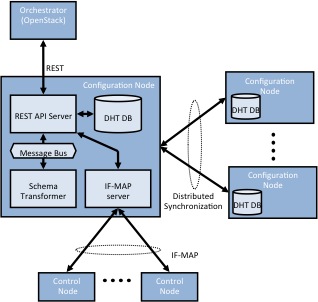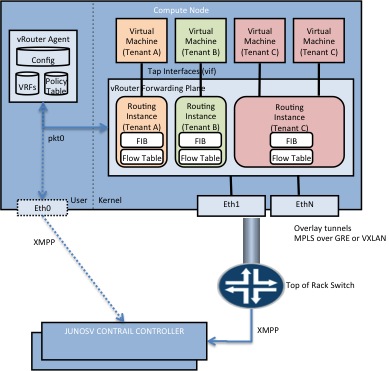The Contrail Virtual Network Controller (VNC) is composed of the
following components:
Configuration node
The configuration node provides a REST API that allows an orchestration system to define virtual-networks, virtual-interfaces and network policies that control the flow of traffic between virtual-networks. The configuration node is responsible to store the persistent state of the system that defines the desired state of the network.
Control node
The control node implements a distributed database that contains
the ephemeral state of the system. Control nodes federate with each
other using the BGP routing protocol.
BGP is also used to communicate with network virtualization enabled routers that support the BGP/MPLS L3VPN protocol.
Control nodes distribute network reachability information to compute-nodes using the XMPP protocol. The same channel is used to distribute desired network configuration state such as the properties of virtual-network interfaces instantiated in a specific compute-node.
Analytics engine
The network analytics engine collects information such as network flow records from the compute-nodes and makes them available via a REST API. Additionally each of the contrail components periodically reports status information about its state and the state of primary data objects in the system.
Compute node
The compute node includes both a user space process (agent) as well as dataplane component that executes as a loadable kernel module on the Host operating system.

Configuration node
The IF-MAP specification defines a set of base operations that can be used to store and query an object graph. The contrail VNC defines an object model (vnc_cfg.xsd)
that expresses network virtualization concepts as IF-MAP identifiers and metadata relations.
The configuration node APIs are autogenerated from this schema.
Several APIs expose higher level concepts that need to be translated to lower level objects. For instance a network-policy may result in both an "access-control list" (ACL) as well as importing network reachability across virtual-networks. The ACL is implemented by the data-plane, while the routing information import/export function is implemented by the control-node. The "schema-transformer" process performs this function whenever necessary.
The configuration node is composed of multiple processes:
API server
The API server is responsible for persisting the state of
the schema objects as well as publishing the corresponding information in the IF-MAP server. It also implements additional functionality such as
IP address management.
Schema transformer
The schema transformer converts higher level concepts into low level objects that can be implemented by the network. For instance it allocates
one or more
routing-instance
objects for a virtual-network. Routing instances correspond to VRF in the dataplane.
Service monitor
The service monitor process creates and monitors virtual-machine instances that implement network services such as NAT or firewalls.
Discovery Service
The discovery service publishes the IP address and port of
the multiple components of the configuration node. The system run multiple instance of each process for high-availability and load balancing purposes.
Domain Name (DNS) Server
Multi-tenant aware DNS server.
Control node
The control-node implements an in-memory distributed database that
contains the transient state of the network such as the current
network reachability information.
For each virtual-network defined at the configuration level, there is
exists one or more routing-instances that contain the corresponding
network reachabilibity. A routing-instance contains the IP host routes
of virtual-machines in the network as well as the routing information
corresponding to other virtual-networks to which virtual-machines are
allowed to communicate directly with.
Control-node processes federate with each other using the BGP protocol and specifically the BGP/MPLS L3VPN extensions. The same protocol is used to interoperate with physical routers that support network virtualization.
The control-node also contains an IF-MAP subsystem which is
reponsible to filter the configuration database and propagate to
the compute node agents only the subset of configuration information
that is relevant to them.
Communication between the control-node and the agent is done via
an XMPP-like control channel. While the message format follows the
XMPP specification the state machine does not yet. This will be
corrected whenever possible.
The control-node receives "subscription" messages from the agent
for routing information on specific routing-instances and for
configuration information pertaining to virtual-machines instantiated
in the respective compute node. It then pushes any current information
as well as updates to both routing and configuration objects relevant
to each agent.
Each agent connects to two control-nodes in an active-active model.
All the routing functionality in the system happens at the
control node level. The agent is unaware of policies that influence
which routes are present in each routing table.
Analytics Engine
The Analytics node provides a REST interface to a time series database
containing the state of various objects in the system such as
virtual-networks, virtual-machines, configuration and control nodes
as well as traffic flow records.
The collected data is stored in a DHT/NoSQL distributed database
(Apache Cassandra)
for scale-out.
The collected objects are defined using an IDL so that the schema of database records can
be easily communicated to users or applications performing queries.
This IDL unifies all diagnostics information on the system including data available through the HTTP interface provided by each contrail process.
Information can be collected periodically or based on event triggers.
Compute node
The compute-node is composed of the vRouter "agent" and
"datapath".
The datapath runs as a loadable kernel module on the host (or dom0)
operating system.
The agent is a user-space process that communicates with the control node. It runs a thrift service that is used by the compute node plugin (e.g.
nova or XAPI) to enable the virtual-interface associated with a
virtual-machine instance.
The dataplane associates each virtual interface with a VRF table
and perfoms the overlay encapsulation functionality. It implements
Access Control Lists (ACLs), NAT, multicast replication and mirroring.




